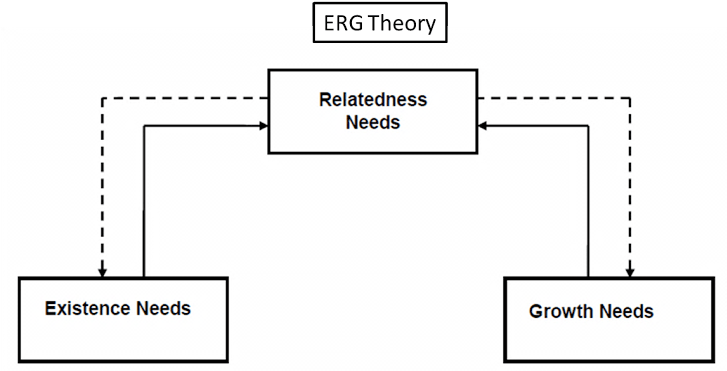ERG theory consists of three groups of core needs: existence, relatedness, and growth. ERG theory shows that a person works on fulfilling these needs simultaneously or separately depending on the difference of goals, status, and the environment.
Clayton Alderfer reworked Maslow‘s need hierarchy to align it with the empirical research. His revised need hierarchy is labeled ERG theory. Alderfer argues that there are three groups of core needs: existence, relatedness, and growth.

Existence Needs
These are constantly and pervasively important in the work setting.
Some of them are job security, suitable working conditions, reasonable working hours, pay and fringe benefits.
- Provides our basic material existence requirements
- They include Maslow’s physiological and safety needs.
Relatedness Needs
These needs focus on how people relate to their social environment.
It involves the relationship with significant others—family, supervisors, co-workers, subordinates, friends and so on.
- The desire we have for maintaining important interpersonal relationships
- These social and status desires require interaction with others.
- They align with Maslow’s social need and the external component.
Growth Needs
These needs are those that compel a person to make creative or productive efforts for him or herself.
The satisfaction of growth is what a person needs to experience in a sense of completeness as a human being.
- An intrinsic desire for personal development. These include the intrinsic component from Maslow’s esteem category and the characteristics included under self-actualization.
ERG theory holds that the fewer existence needs are satisfied the more they will be desired, but the more existence needs are satisfied; the more relatedness needs will be desired.
The fewer relatedness needs are satisfied, the more both existence and relatedness needs will be desired, but the more relatedness needs are satisfied, the more growth needs are desired.
In this way, Alderfer distinguishes between chronic needs which persist over a period of time and the episode needs which are situational and can change according to the environment.
ERG Theory vs Hierarchy of Needs Theory
ERG Theory is an Improvement from Hierarchy of Needs Theory.
Maslow model suggested that in modern social worker has already satisfied their lower level need, so they are now motivated by higher needs.
On the other hand, ERG theory suggested that the failure to satisfy relatedness or growth needs will cause renewed interest in existence need.
In addition to collapsing Maslow’s five into three, Alderfer’s ERG theory also differs from Maslow’s in that:
- More than one need may be operative at the same time.
- If the gratification of a higher-level need is stifled, the desire to satisfy lower-level need increases.
- ERG theory does not assume that there exists a rigid hierarchy. A person can be working on growth even though existence or relatedness needs are unsatisfied, or all three need categories could be operating at the same time.
- ERG theory also contains a frustration-regression dimension:
- Maslow argued that an individual would stay at a certain need level until that need was satisfied. ERG argues that multiple needs can be operating as motivators at the same time.
- ERG theory notes that when a higher-order need level is frustrated; the individual’s desire to increase a lower-level need takes place.
For Instance: When growth need aggravates, then an individual might be motivated to accomplish the relatedness need and if there are issues in accomplishing relatedness needs, then he might be motivated by the existence needs. Thus, frustration/aggravation can result in regression to a lower-level need.
- While Maslow’s need hierarchy theory is rigid as it assumes that the needs follow a specific and orderly hierarchy and unless a lower-level need is satisfied, an individual cannot proceed to the higher-level need; ERG Theory of motivation is very flexible as he perceived the needs as a range/variety rather than perceiving them as a hierarchy. According to Alderfer, an individual can work on growth needs even if his existence or relatedness needs remain unsatisfied. Thus, he gives an explanation of the issue of “starving artist” who can struggle for growth even if he is hungry.
- ERG theory is more consistent with our knowledge of individual differences among people.
- Variables such as education, family background, and cultural environment can alter the importance or driving force that a group of needs holds for a particular individual.
- The evidence demonstrating that people in other cultures rank the need categories differently would be consistent with ERG theory.